
8 Simple Moves for Desk Workers to Relieve Back & Neck Pain
8 Simple Moves for Desk Workers to Relieve Back & Neck Pain

Modern Problem with a Simple Solution
That nagging ache between your shoulder blades at the end of the workday? The stiffness in your neck and lower back after hours hunched over a screen? You're not alone. Research indicates that many employees spend over seven hours a day sitting, a sedentary lifestyle that leads to musculoskeletal issues and millions of lost workdays each year.
The good news? You don't have to live with the discomfort. You don't need an expensive gym membership or complex equipment. In this comprehensive guide, we’ve compiled the most effective strategies into a simple routine. We'll show you 8 simple exercises you can do at your desk or at home, coupled with essential ergonomic tips, all in just 5-10 minutes a day.
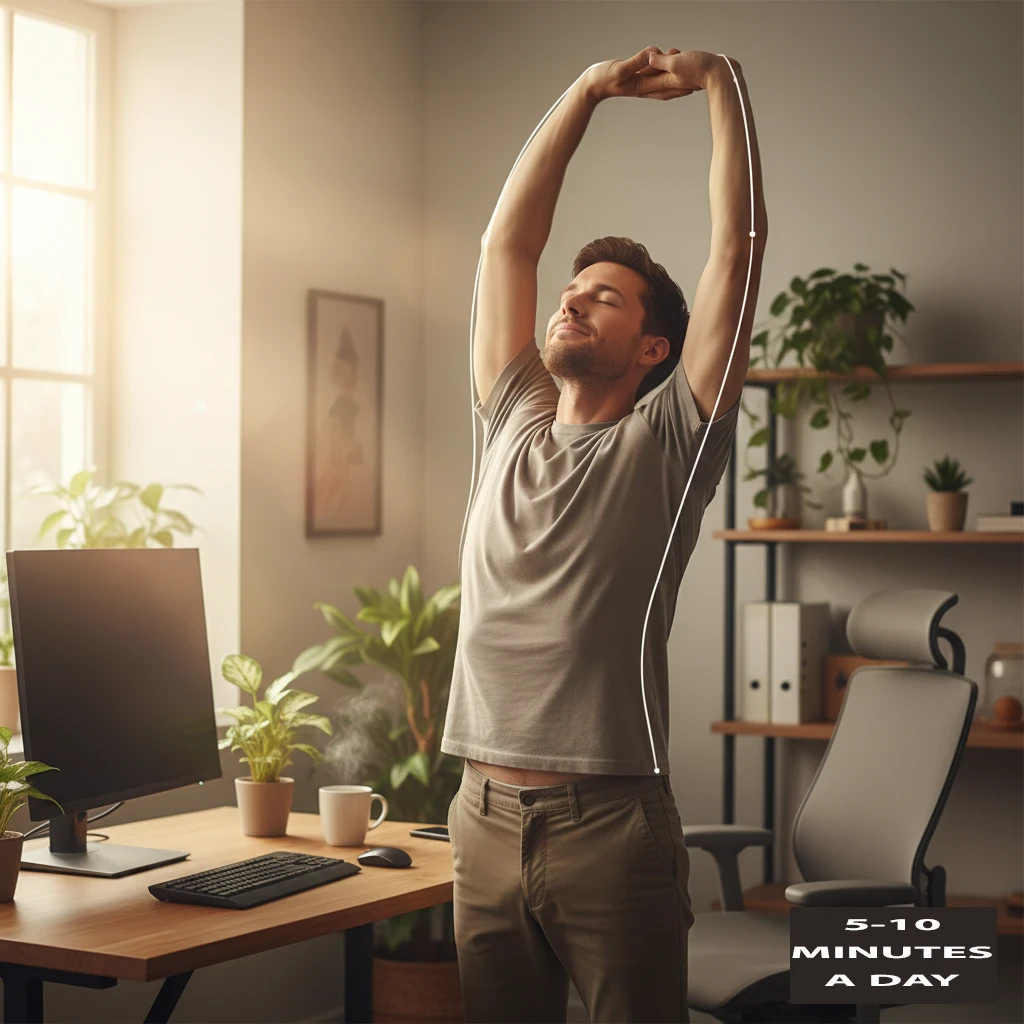
Why Good Posture is a Non-Negotiable for Your Health
Good posture isn't just about looking confident; it's the foundation of your overall health. Sitting incorrectly for long periods can lead to:
Chronic pain in your back, neck, and shoulders.
Tension headaches caused by tight neck and scalp muscles.
Decreased energy and focus due to poor circulation.
Compromised breathing from a constricted chest cavity.
Increased risk of long-term health issues like herniated discs.
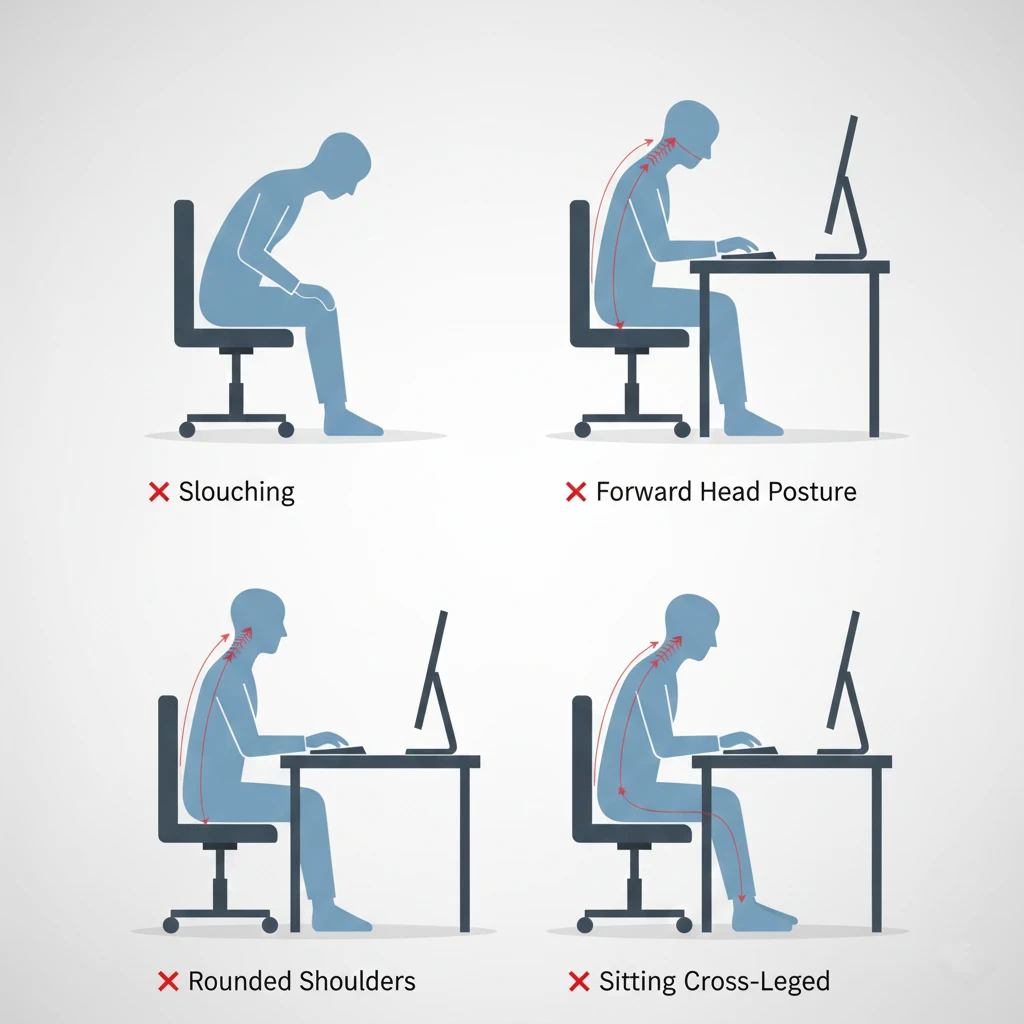
The Most Common Posture Mistakes (And How to Spot Them)
The first step to fixing your posture is recognizing the problem. Are you guilty of any of these?
Slouching in your chair, rounding your entire spine.
Forward Head Posture ("Text Neck") craning your neck toward your screen.
Rounded Shoulders from hunching over your keyboard.
Sitting Cross-Legged for prolonged periods, which can misalign your hips.
No Lumbar Support, flattening the natural curve of your lower back.
The Comprehensive Routine: 8 Exercises to Fix Your Posture & Ease Pain
Compiled from the best practices in your sources, these exercises are easy to perform. Aim to do this routine once or twice daily.
Seated Exercises (Discreet & Effective)
1. Shoulder Blade Squeeze
Why it works: Strengthens the upper back muscles that pull your shoulders back, fighting the hunch.
How to do it: Sit tall with your arms relaxed. Squeeze your shoulder blades together as if you're trying to hold a pencil between them. Hold for 5 seconds, then release. Repeat 10-15 times.
Pro Tip: Keep your shoulders down—avoid shrugging them up to your ears.

2. Seated Spinal Twist
Why it works: Improves thoracic spine mobility and relieves stiffness in the mid and lower back.
How to do it: Sit upright with feet flat. Place your right hand on the back of your chair and your left hand on your right knee. Gently twist your torso to the right. Hold for 15-30 seconds, breathing deeply. Repeat on the left side.
Pro Tip: The twist should come from your torso, not your neck. Keep your hips facing forward.
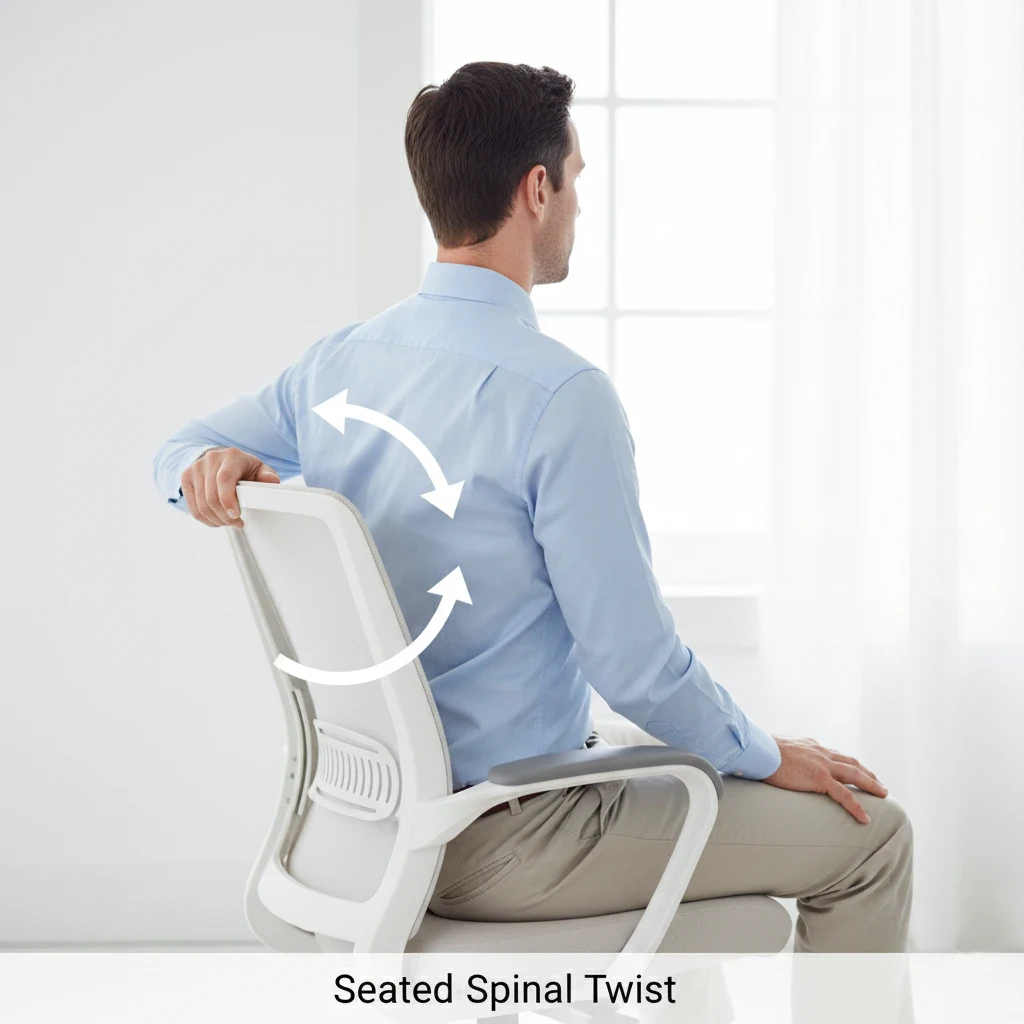
3. Seated Cat-Cow Stretch
Why it works: Increases flexibility and fluidity throughout your entire spine.
How to do it: Sit on your chair with hands on your knees. Inhale as you arch your spine, stick your chest out, and look up slightly (Cow Pose). Exhale as you round your spine, tuck your chin to your chest, and draw your belly button in (Cat Pose). Repeat 5-10 times slowly.
Pro Tip: Sync your movement with your breath for a calming, mind-body effect.

4. Seated Hamstring Stretch
Why it works: Counteracts tight hamstrings from sitting, which is a major contributor to lower back pain.
How to do it: Sit at the edge of your chair. Extend one leg straight out in front of you, heel on the floor. Keeping your back straight, hinge forward at your hips until you feel a stretch in the back of your thigh. Hold for 20-30 seconds and switch legs.
Pro Tip: Imagine your chest moving toward your thigh, not your forehead toward your knee, to keep your back straight.

5. Wrist & Finger Stretch
Why it works: Prevents strain from typing and mousing, reducing the risk of carpal tunnel syndrome.
How to do it: Extend your right arm, palm facing up. Gently pull your fingers down with your left hand to stretch the forearm. Hold for 15-20 seconds. Then, make gentle fists and rotate your wrists in both directions. Repeat with the other hand.
Standing Exercises (For a Full-Body Reset)
6. Chest Opener Stretch
Why it works: Directly counteracts the rounded-shoulder posture from hunching over a desk.
How to do it: Stand tall. Interlace your fingers behind your back. Straighten your arms and gently lift them away from your body, squeezing your shoulder blades together. Hold for 15-30 seconds.
Pro Tip: If you can't clasp your hands, hold onto the ends of a small towel or your sleeves.
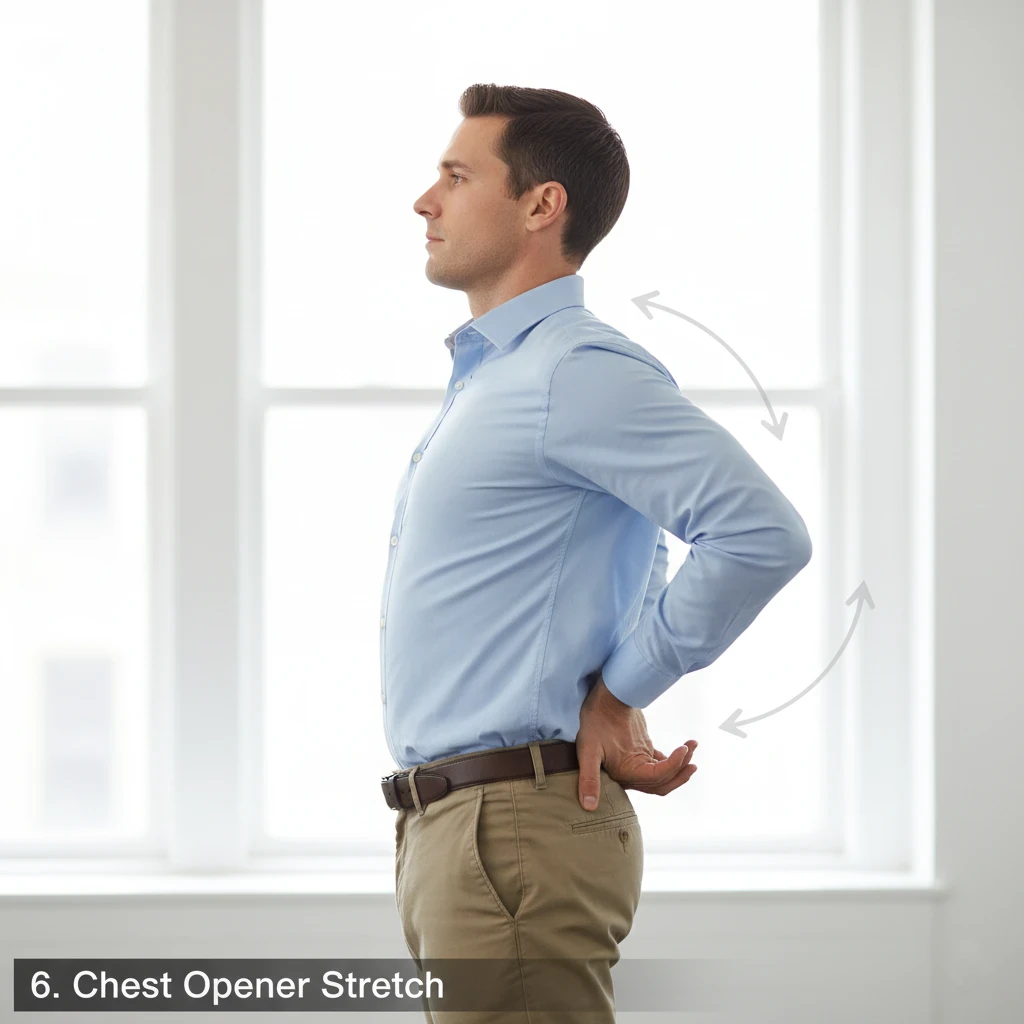
7. Hip Flexor Stretch
Why it works: Prolonged sitting shortens hip flexors, which pull on the pelvis and cause lower back pain. This stretch releases them.
How to do it: Step into a lunge with your right foot forward. Keep your back straight and gently push your hips forward until you feel a stretch in the front of your left hip. Hold for 20-30 seconds. Switch sides.
Pro Tip: For balance, you can do this while holding onto your desk.
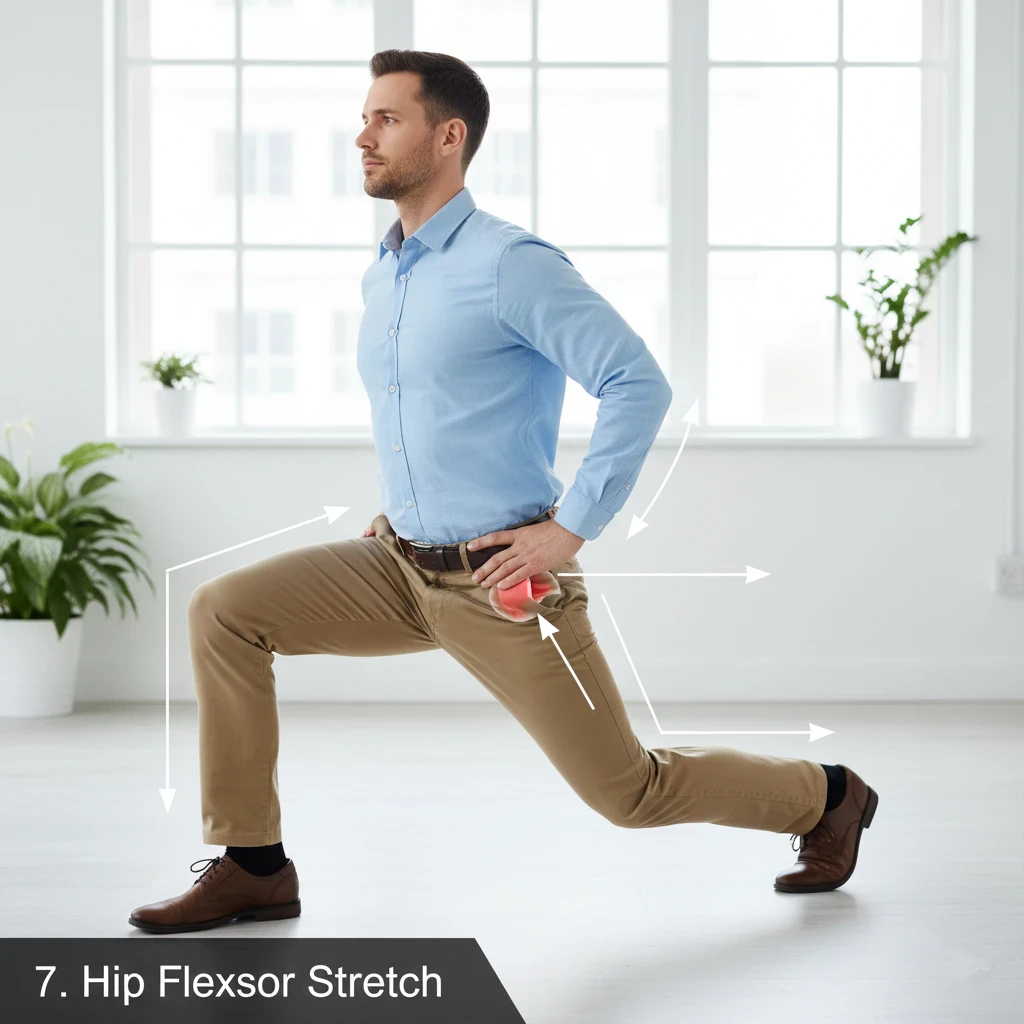
8. Wall Angels
Why it works: This is a powerhouse for posture. It retrains your shoulder mobility and strengthens the muscles needed to stand tall.
How to do it: Stand with your back against a wall (head, shoulders, and buttocks touching). Raise your arms to form a "W" with elbows and wrists against the wall. Slowly slide your arms up to form an "I," then back down. Keep contact with the wall throughout. Repeat 10 times.
Pro Tip: If you can't keep contact, step your feet slightly away from the wall to make it easier.

Golden Rules for a Posture-Friendly Workday
Exercises alone aren't enough. Integrate these daily habits to build a foundation of good health.
Optimize Your Workspace (Ergonomics 101):
Chair: Your feet should be flat on the floor, knees at a 90-degree angle. Use lumbar support to maintain the natural curve in your lower back.
Monitor: The top of your screen should be at or slightly below eye level, about an arm's length away.
Keyboard & Mouse: Keep them close, so your elbows stay near your body and form a 90-120 degree angle.
Schedule Movement Breaks: Use the 20-20-20 rule: Every 20 minutes, look at something 20 feet away for 20 seconds. More importantly, stand up and walk for a minute or two every 30-60 minutes.
Invest in Support: A lumbar cushion or an ergonomic chair can make a world of difference. The support helps maintain alignment without you having to think about it.
Hydrate: Proper hydration supports muscle elasticity and joint health. Keep a water bottle at your desk as a reminder.
Incorporate Micro-Movements: While seated, do ankle circles, leg extensions, or gentle neck tilts. These small movements keep blood flowing and prevent stiffness from setting in.
Conclusion: Your 5-Minute Investment for a Healthier You
Integrating these simple exercises and tips into your daily routine isn't a luxury—it's an investment in your health, productivity, and overall well-being. Within a few days, you'll notice a significant difference in your comfort, energy levels, and focus.
Remember, consistency is key. Share this routine with your colleagues and create a healthier, more supportive work environment for everyone.
Frequently Asked Questions (FAQs)
1. How often should I do these desk stretches?
Aim for the full 5-10 minute routine once or twice a day. Additionally, take 30-second micro-breaks every 30-60 minutes to perform one or two stretches (like shoulder shrugs or neck rolls) to break up long periods of stillness.
2. I'm self-conscious about stretching at my desk. Any advice?
Choose discreet stretches like the Seated Spinal Twist, Wrist Stretches, and Shoulder Blade Squeezes. You can perform these subtly without drawing attention. For standing stretches, take a quick walk to the water cooler or a quiet corner.
3. Can stretching really improve my productivity?
Absolutely. Studies show that brief stretching breaks improve blood flow, reduce musculoskeletal discomfort, and enhance mental alertness. When you're in less pain and have better circulation, your focus and efficiency naturally improve.
4. What if a stretch causes pain?
Stretching should create a feeling of mild tension, not sharp or radiating pain. If you feel pain, stop immediately. You may be pushing too far or have an underlying issue. Consult a healthcare professional if pain persists.
References & Further Reading:
- Robertson, M., Amick, B., DeRango, K., et al. (2013). The effects of an office ergonomics intervention on musculoskeletal discomfort and productivity. Journal of Occupational Rehabilitation, 23(1), 1–14. https://www.semanticscholar.org/paper/Effect-of-Office-Ergonomics-Intervention-on-Amick-Robertson/2e310470bed4a0b59913c8aba73e5b8072e5f79b
- Thorp, A., Owen, N., Neuhaus, M., & Dunstan, D. (2011). Sedentary behaviors and subsequent health outcomes in adults: A systematic review of longitudinal studies, 1996–2011. American Journal of Preventive Medicine, 41(2), 207–215. https://doi.org/10.1016/j.amepre.2011.05.004
- Public Health England. (2016). Health matters: getting every adult active every day
- Cagnie, B. et al. (2007). Individual and work related risk factors for neck pain among office workers. European Spine Journal


































